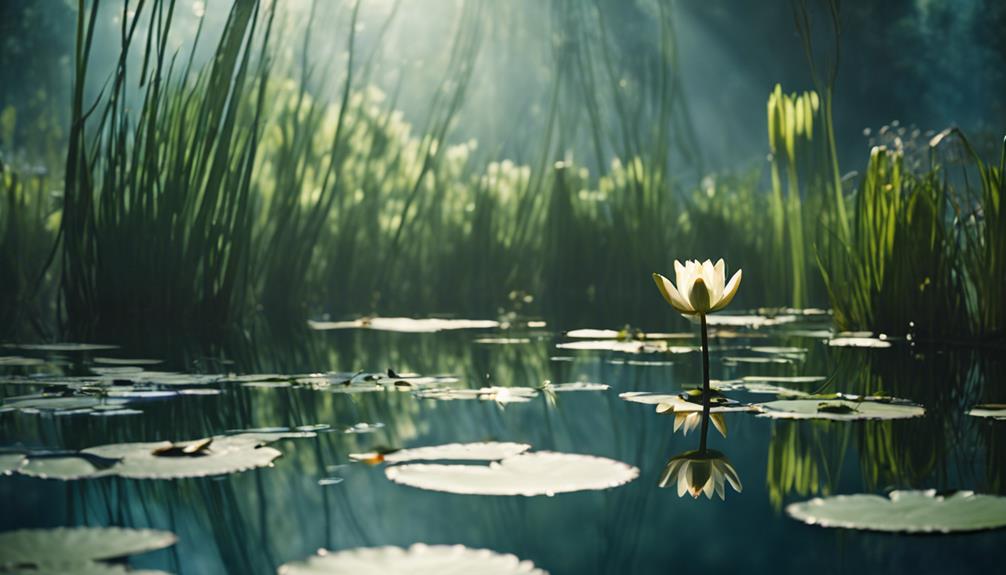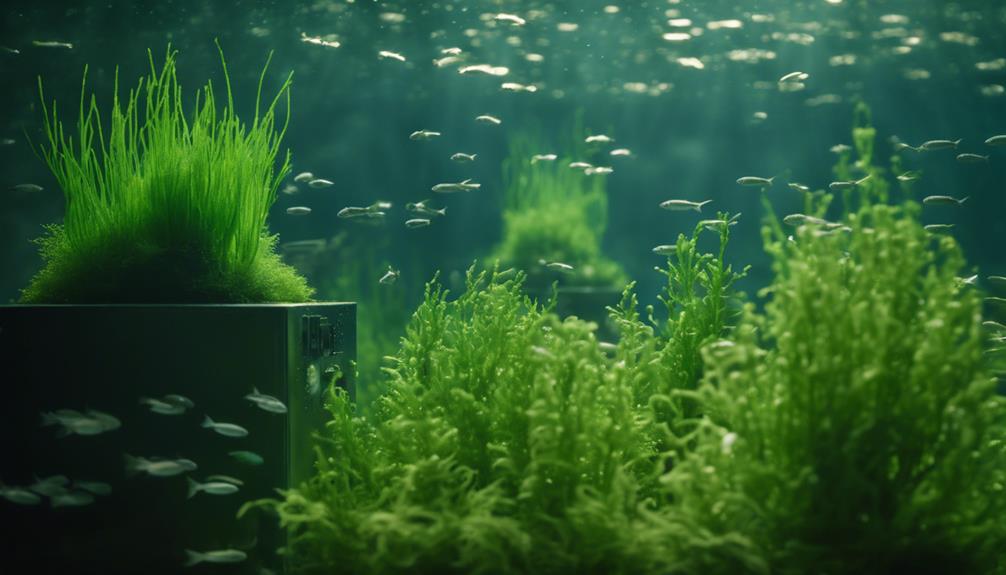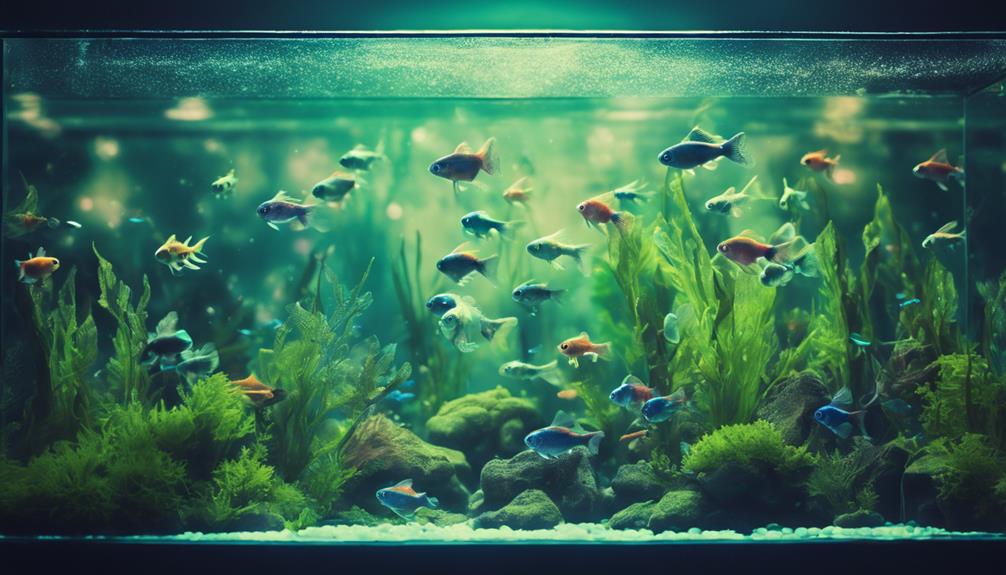You need to select aquatic plants that not only thrive in your specific pond conditions but also provide ideal oxygenation, nutrient absorption, and aesthetic appeal. Oxygenating plants perform photosynthesis, absorbing carbon dioxide and releasing oxygen, essential for aquatic organisms. They remove excess nutrients, preventing algae buildup and maintaining cleaner water. Popular oxygenating plants like Hornwort, Anacharis, and Waterweed thrive in various water temperatures and lighting conditions. Consider evaluating your pond's conditions, including water depth, temperature, and nutrient levels, to determine the best oxygenating plants for your specific environment. By choosing the right plants, you'll create a balanced ecosystem that supports vibrant aquatic life.
Table of Contents
Key Takeaways
- Oxygenating plants like Hornwort and Anacharis provide excellent aeration and nutrient absorption, making them ideal for ponds with low water circulation.
- Choose plants that thrive in your pond's specific water temperature and lighting conditions to ensure optimal oxygen production.
- Combining different oxygenating plant species creates a balanced ecosystem and promotes healthy aquatic life.
- Divide and replant oxygenating plants regularly to maintain their effectiveness and prevent overgrowth.
- Strategically placing plants around the pond's perimeter or in clusters can enhance aeration and create a visually appealing water garden.
Understanding Oxygenating Plants
Understanding that oxygenating plants are the unsung heroes of pond ecosystems, working tirelessly to replenish oxygen levels and maintain a delicate balance.
These plants perform photosynthesis, absorbing carbon dioxide and releasing oxygen, which is essential for the survival of fish, beneficial bacteria, and other aquatic organisms. In hot summer months or stagnant conditions, oxygenating plants are essential in preventing oxygen depletion in the water.
They also play a key role in removing excess nutrients, such as nitrates and phosphates, from the water, thereby preventing algae buildup and maintaining cleaner water for pond inhabitants.
Popular oxygenating plants like Hornwort, Anacharis, Waterweed, Cabomba, and Eelgrass can thrive in various water temperatures and lighting conditions, making them ideal for different pond settings.
Importance of Aeration in Ponds
Incorporating aeration into your pond's design is essential, since it directly impacts the overall health and well-being of aquatic life by maintaining ideal oxygen levels.
Without sufficient oxygen, your pond's ecosystem can quickly deteriorate, leading to stagnant water and unhealthy aquatic life. You can't rely solely on oxygenating plants to provide oxygen; they're just one part of the equation.
Aeration plays a vital role in keeping it clear and maintaining water quality.
When oxygen levels drop, algae growth accelerates, and your pond becomes a breeding ground for disease.
By providing oxygen, you guarantee a balanced aquatic ecosystem where plants and animals thrive. Aeration also helps distribute oxygen evenly, preventing 'dead zones' where oxygen levels are critically low.
Don't underestimate the importance of aeration; it's the backbone of a healthy pond.
Benefits of Oxygenating Plants

You can augment your pond's aeration system with oxygenating plants, which produce oxygen as a byproduct of photosynthesis, thereby increasing dissolved oxygen levels and supporting a balanced ecosystem.
By incorporating oxygenating pond plants into your pond, you'll not only improve water quality but also create a thriving environment for aquatic life.
These plants absorb excess nutrients, preventing algae blooms and reducing the risk of water pollution.
As they release oxygen, they help to keep your pond's water clear and healthy.
Oxygenating plants are especially beneficial in areas with low water circulation or high levels of organic matter.
By supporting the growth of these plants, you'll be helping to keep your pond's ecosystem in balance.
Clear water isn't just aesthetically pleasing; it's also essential for the health and well-being of your pond's inhabitants.
Top Oxygenating Plant Species
When selecting plants to augment your pond's aeration system, consider the following top oxygenating plant species, each offering unique benefits and characteristics. These plants will help create a thriving ecosystem, providing oxygen for fish and other aquatic organisms.
- Hornwort (Ceratophyllum demersum): A popular choice among pond enthusiasts, providing excellent oxygenation and nutrient absorption.
- Anacharis (Elodea canadensis): A hardy plant that can tolerate a wide range of water temperatures and lighting conditions, making it an effective oxygenator.
- Waterweed (Elodea densa): Provides excellent oxygenation and shade, helping to keep algae at bay and maintain a balanced ecosystem.
- Cabomba (Cabomba caroliniana): A fast-growing plant that can thrive in a variety of water conditions, making it an ideal choice for oxygenating ponds.
When introducing these oxygenating pond plants to your water garden, keep an eye on their growth and adjust as needed. By incorporating these aquatic plants into your pond's aeration system, you'll create a healthy and balanced environment for your fish and other aquatic life to thrive.
Assessing Pond Conditions

Your pond's water quality and ecosystem balance depend on accurate assessments of its conditions, including factors like water depth, temperature, and nutrient levels.
To get a thorough understanding of your pond's environment, you'll need to evaluate its unique characteristics. Start by measuring water temperatures, which can fluctuate greatly between shallow water and deeper areas. Additionally, consider the pond's water feature, such as its shape, size, and any Boggy Areas that may be present.
Next, analyze the pond's water chemistry by testing for pH levels, nitrogen, phosphorus, and other essential nutrients. This information will help you identify potential issues, such as algae blooms or oxygen depletion, which can negatively impact your pond's ecosystem.
Plant Compatibility and Care
Selecting aquatic plants that coexist harmoniously and thrive in your pond's unique environment requires careful consideration of their individual needs and compatibility. You'll want to verify that the plants you choose can tolerate your pond's specific water conditions and receive the necessary care.
When it comes to plant compatibility, you should consider the following:
- Lighting needs: Some plants require intense sunlight, while others prefer shade. Make sure to group plants with similar lighting requirements together.
- Temperature tolerance: Different plants have varying temperature tolerances, so be certain to choose plants that can thrive in your pond's temperature range.
- Water depth: Plants have unique depth requirements, so guarantee you're providing the right environment for each species.
- Nutrient requirements: Some plants are heavy feeders, while others have low nutrient needs. Balance your plant selection to avoid depleting your pond's nutrient resources.
Maintaining Healthy Water Quality

Properly managing your pond's water chemistry is essential to maintaining healthy water quality, as it directly impacts the well-being of your aquatic plants and the overall ecosystem.
You can achieve this by introducing the best oxygenating pond plants, such as Water Lettuce and Water Lilies, which absorb excess nutrients and produce oxygen.
These plants help regulate nutrient levels, preventing algae blooms that can deplete oxygen and create an unhealthy environment.
Regularly test the water for pH, ammonia, and nitrite levels to verify they're within the suitable range for your plants.
Make adjustments as needed to prevent sudden changes that can stress your plants.
Additionally, consider implementing a regular water change schedule to remove built-up toxins and maintain a balanced ecosystem.
Enhancing Pond Aesthetics
As you consider enhancing your pond's aesthetics, you'll want to explore the wide range of colorful plant varieties that can add visual interest to your water feature.
By selecting plants with varying textures, forms, and hues, you can create a unique and stunning visual display.
You'll also want to think about incorporating water garden designs that complement your plant choices and create a harmonious, balanced look.
Colorful Plant Varieties
When designing an aesthetically pleasing pond, incorporating colorful plant varieties is essential to create a visually stunning aquatic ecosystem. You can choose from a range of vibrant green plants that not only add visual interest but also provide oxygen for your pond.
Some popular options include:
- Pink Rotala, an oxygenating plant that grows quickly and reaches up to 20cm in height, adding a pop of color to your Water Gardens.
- Upright Water Milfoil, with its feathery, green foliage that grows in dense clusters, providing plenty of oxygen for your aquatic ecosystem.
- Arrowhead plants, which have beautiful, arrow-shaped leaves that come in a range of colors, including green, bronze, and purple, adding a touch of elegance to your pond.
- Brahmi, with its small, delicate white flowers and tiny, oval-shaped leaves that add a touch of sophistication to your pond, while also providing a natural stress reliever for fish and other aquatic life.
Water Garden Designs
By thoughtfully combining aquatic plants with varying textures, colors, and forms, you can effectively create a visually appealing water garden that not only enhances pond aesthetics but also promotes a healthy ecosystem.
Incorporating a mix of plants like Hornwort and Vallisneria, which provide a natural, effortless look, can add depth and visual interest to the pond's landscape.
Strategically placing plants around the pond's perimeter or in clusters can create a sense of harmony and balance, while also blocking sunlight and reducing algae growth.
Floating plants like Water Lettuce and Duckweed can be used to add a decorative touch to the pond's surface, providing shade and helping to control algae blooms.
By incorporating submerged plants like Anacharis and Eelgrass, you can create a natural, hidden filtration system that removes excess nutrients and toxins from the water, promoting clear, healthy water.
Planting and Propagation Tips

To guarantee the successful establishment of oxygenating plants in your pond, divide and replant them every 2-3 weeks during the growing season. This will maintain their health and promote growth.
When planting, make sure to anchor them down with stones or planting baskets to prevent them from floating away or getting washed out.
Some additional tips to guarantee the success of your oxygenating plants:
Monitor nutrient levels in your pond to support ideal growth, as excess nutrients can lead to algae blooms and negatively impact plant health.
Plant oxygenating plants in the desired location, taking care to secure them properly.
Regularly clean your pond to remove debris and excess nutrients that can hinder plant growth and water quality.
Be mindful of your plants' growth and propagate them regularly to maintain a balanced ecosystem.
Controlling Plant Overgrowth
You'll need to implement regular maintenance practices to prevent your oxygenating plants from overgrowing and compromising your pond's water quality. Controlling plant overgrowth is essential to maintaining a healthy ecosystem balance. Excess plant material can be removed by hand or with the use of aquatic plant rakes and cutters, taking care not to disturb the pond's ecosystem.
| Maintenance Task | Frequency |
|---|---|
| Prune and trim plants | Every 2-3 weeks |
| Monitor nutrient levels | Monthly |
| Thin out submerged plants | Every 2-3 weeks |
Frequently Asked Questions
Which Plant Is the Best Oxygenator of Water?
You're looking for the best oxygenator of water? Consider Hornwort, producing up to 5.3 cubic feet of oxygen per day, ideal for maintaining healthy water clarity in aquatic ecosystems with varying oxygen levels, water temperature, and plant density.
Which Aquatic Plants Produce the Most Oxygen?
You'll find that Hornwort and Anacharis top the list for oxygen yield, thanks to their high photosynthesis rates, dense growth, and efficient nutrient uptake, making them ideal for improving water quality through increased oxygen production.
What Underwater Aquarium Plant Is Known to Provide Good Oxygen Underwater?
As you venture into the world of aquatic beauty, you'll find that hornwort is the submerged garden superstar, providing good oxygen underwater through diligent plant care, ensuring crystal-clear water clarity and boosting oxygen levels for a thriving fresh decor.
What Is an Oxygenating Plant?
You're likely familiar with oxygenating plants, which enhance oxygen levels in water, providing numerous benefits, such as supporting aquatic ecosystem health, acting as natural filters, and absorbing carbon dioxide, ultimately promoting water health and clarity.
Conclusion
As you venture into the world of aquatic plants, remember that the delicate balance between oxygenation and overgrowth is a fine line.
Oxygenating plants are the unsung heroes of pond health, quietly purifying water and supporting aquatic life.
On the other hand, unchecked growth can spell disaster.
By choosing the right plants and maintaining a watchful eye, you'll create a thriving ecosystem where life flourishes – and not just survives.

